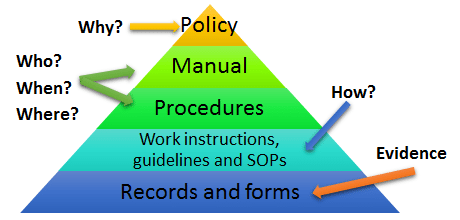 Strahinja Stojanovic
Strahinja Stojanovic
November 28, 2016
Development of the documentation and record control system for your ISO 14001-based EMS (Environmental Management System) is a very important part of the implementation, because it will define the method of creation, publishing, withdrawal, and use of your documents and records. It is up to the organization to create the most suitable documentation, because it will affect the way you maintain and improve your EMS. It can be a burden that will make your EMS harder to maintain, and therefore become just a formality, or it can facilitate the maintenance and enable the company to yield the benefits of ISO 14001 implementation. For more information about the benefits of implementing ISO 14001, see: 6 Key Benefits of ISO 14001.
Before starting to develop EMS documentation, it is important to get a clear picture of the purpose of each type of document, and where it belongs in the documentation hierarchy. There are several types of documents used to establish an EMS: policy, objectives, manual, procedures, work instructions, guidelines or SOPs (Standard Operating Procedures), and records and forms. Every type of document and record has its place and role in the EMS, as represented below:

At the beginning of the implementation and developing of the documentation, people are often confused on which document is the most important and what document comes before another. The simplest way to determine the hierarchy is to see who writes the document, who is it for, and what is its purpose. If the document is written by the top management, then it goes on the top; if it is filled in by the employees, it goes on the bottom of the pyramid.
It is true that the international standard for Environmental Management Systems (ISO 14001) requires certain documentation (see this article: List of mandatory documents required by ISO 14001:2015). The purpose and the benefits of the EMS documentation are manifold: it provides a clear framework of the operations in an organization, it allows consistency of processes and better understanding of the EMS, and it provides evidence for achievement of objectives and goals. When designing EMS documentation, you should focus on efficiency and create processes and documents that are applicable in your organization. The best way to start producing the documents is to understand their role and purpose before creating and enforcing them. The documentation for an Environmental Management System should be structured as follows:
1) EMS Policy. A policy represents a declarative statement by an organization – something like a constitution of the system – and all other documents arise from it. The policy is written by the top management and its purpose is to define the general direction and aim of the EMS. The Environmental Policy also provides a framework for establishing EMS Objectives. For more information about the EMS Policy, see: How to write an ISO 14001 environmental policy.
2) EMS Manual. Although it is not a mandatory document according to ISO 14001, it is often used to document the scope of the EMS and the main elements of the EMS and their interaction, and reference to related documents. Since it is a very common document, it is usually the first document that the certification body wants to see to get familiar with the system. In cases where it is a small company or a company with simple hazards, all procedures can be placed into an EMS Manual. For more information about the EMS Manual, see: What is an environmental management system manual?
3) Procedures. EMS procedures can have different formats and structures. They can be narrative, i.e., described through text; they can be more structured by using tables; they can be more illustrative, i.e., flow charts; or they can be any combination of the above. Procedures should include title, purpose, scope, responsibilities and authorities, description of activities, and reference to relevant work instructions, SOPs, and records.
4) Work instructions, guidelines, and SOPs. The main purpose of work instructions is to avoid nonconformities by explaining exactly how a certain activity is carried out. It is usually written for the activities within the process with the highest chances of nonconformities occurring, or for complex or rarely conducted activities. Work instructions can be part of a procedure, or they can be referenced in a procedure. Generally, work instructions have a similar structure to the procedures and cover the same elements; however, the work instructions include details of activities that need to be realized, focusing on the sequencing of the steps, tools, and methods to be used and required accuracy.
5) Records and forms. Finally, there must be some evidence that activities and processes are conducted in the way prescribed in the procedures and work instructions. This is the main purpose of the records and forms. Most of them are filled in by employees, but some of them (e.g., Management Review Minutes) are filled in by the top management. The best way to make them practical is to avoid requiring employees to write essays. Having records with checkboxes instead of empty rows for employees to write sentences will ensure that the forms or records are filled in quickly and easily.
Dimensioning the EMS documentation based on your organizational needs is essential for a functional EMS. Moreover, properly structured documentation will make your operations much easier, while incorrect documentation will bring you nothing but trouble.
Use this white paper: Checklist of Mandatory Documentation Required by ISO 14001:2015 to guide you in structuring each document used in the implementation process.